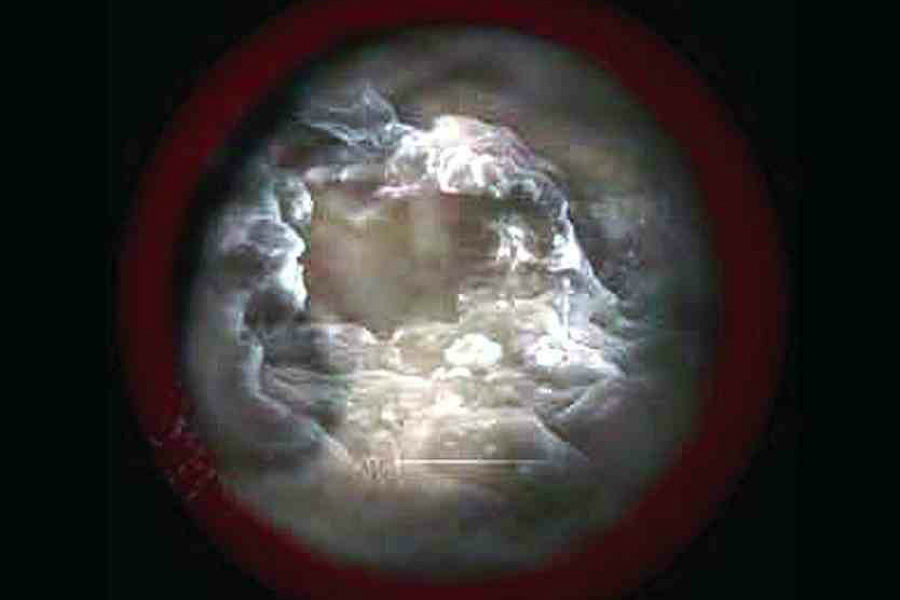Spreading The Disease

C James Fagan explores the enduring relationship between pop culture and our oldest fears.
All around us there exists a myriad of tiny invisible creatures, creatures that have the ability to change us physically and mentally. These things exist all around you and they lay in wait in the bodies of others longing to get inside you. They are viruses; they have infected our imagination providing handy metaphors for contemporary life.
The idea of virus as metaphor is currently infesting a corner of Gina Czarnecki’s exhibition at The Bluecoat. This infection takes the form of an interactive installation entitled ‘Contagion’ (pictured). Czarnecki’s installation turns you from innocent viewer into Patient Zero – an unwitting pawn in the spread of some terrible pandemic panic. It plays on the fear of such a pandemic, as it mixes in tropes from films. While in the space, sharp hard military communications fly through the air until gunfire spits out; designed to control the virus, to stop the carrier, to kill you.
What is it about the virus that taps into human fears, fears which have been part of human culture for such a long time? Remember that Plague is one of Horsemen of the Apocalypse and that we are well aware of the effects of viral pandemics, the most recent being the Spanish Flu outbreak which devastated an already beleaguered Europe after the First World War.
Add to this increasing knowledge we’ve developed regarding the mechanisms of the spread of diseases, the virus appears to be a perfect incubator for metaphor. The virus can be used as metaphor for an insidious invisible change leaving you, the uninfected, alone and vulnerable. This concept often rears its ugly head in the horror genre; from the exotic infection of Dracula’s bite to the rabid spread of zombies, fear spreads. This fear of infection can be seen in two of the early films of David Cronenberg. His films Shivers (1975) and Rabid (1977) each feature characters that become infected and then transformed into the spearhead of a new sexual virus whose sole purpose is to breed. Not only do these films touch on the fear of the other, they also touch on how our society can be brought down by something small and unknown operating towards horrible evolutionary ends.
A prime example of the virus as insidious invader finds its perfect host in John Carpenter’s 1982 film The Thing, where the alien virus has waited for millions of years for new hosts. Once it is out it slips into an isolated Antarctic research outpost infecting its inhabitants even before they realise it. Within The Thing we recognise a fear of how fragile our bodies are, especially how through infection the human becomes inhuman, changed by microscopic invaders beyond all recognition. You also have to add to this fear of viral invasion a paranoia about where or who this infection will come from; it’s enough to make you break out in a cold sweat.
As The Thing virus spreads through the outpost we see the total breakdown of the meagre social bonds that kept the group together. Ironically, they become as selfish as the virus – concerned only with their own survival. This comes to a grim conclusion as the only survivors are so contaminated by fear and paranoia of what flows in the others blood, they opt to freeze to death rather than approach each other. In The Thing we have a microcosm of how society reacts to disease and sickness in general and in retrospect it’s easy to read The Thing as metaphor for AIDS; a virus dormant in another species for years quickly spreads through a small group of people amidst an atmosphere of fear and rumour. The extra-terrestrial virus in The Thing doesn’t represent a single disease; rather it represents the fear of contagion, becoming sick and dying and of course the fear of the carriers of that contagion.
Often it is fear that spreads quicker than infection. In a world of 24 hour news and social media, a virus, or rather the idea of a virus, can spread further and faster than before. During the opening years of the 21st century we have seen media spread infection with SARS and Bird Flu. In both cases the fear of the virus affected more people than it did physically; I can’t recall anyone I know being effected by either.
There is as yet no antidote for this fear. No wonder then Czarnecki quotes Australian Head of Public Health Stephen Corbett: “The fear of the pandemic is more lethal that the pandemic itself.” Perhaps in our use of the virus metaphor lies the attempt to discover some kind of antidote, to inoculate us from these fears. Horror films act as catharsis, allowing us to express contemporary fears or at least to look at those fears from a distance. By exposing ourselves little by little to examples of this kind of fear through fiction and art, we could be building up an immunity of sorts; in doing so protecting ourselves from some future imagined contagion. Either way, the legacy of contagion in cultural production has and continues to be infectious; long may this be the case.
C James Fagan
Image courtesy Gina Czarnecki





